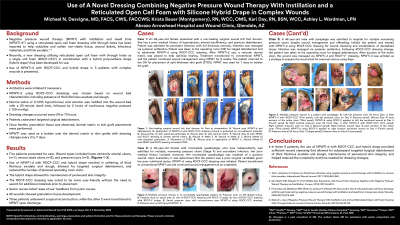Case Series/Study
(CS-051) Use of Negative Pressure Wound Therapy With Instillation and a Novel, Single-Piece, Foam Dressing to Provide Hydromechanical Removal of Devitalized Tissue from Complex Wounds

Negative pressure wound therapy (NPWT) with instillation and dwell time (NPWTi-d*) using a reticulated open cell foam dressing with through holes has been reported to help solubilize and soften non-viable tissue, wound debris, infectious materials, and thick exudate.1-4 Recently, a novel, single-piece foam dressing with 10 mm diameter x 8 mm deep wound interface holes (ROCF-CCC†) has been developed to provide hydromechanical removal of devitalized tissue, and excessive wound detritus, and to potentially reduce the frequency of surgical debridements. Here, NPWTi-d using ROCF-CCC dressing, and hybrid adhesive drape (hybrid drape§) are applied to complex wounds.
Methods:
Antibiotics were initiated if necessary. NPWTi-d using ROCF-CCC dressing was chosen based on wound bed characteristics including presence of thick, fibrinous, exudate and slough. Normal saline or 0.125% hypochlorous acid solution was instilled into the wound bed with a 20-minute dwell time, followed by 2 hours of continuous negative pressure (-125 mmHg). Dressing changes occurred every 24 to 72 hours. Patients underwent targeted surgical debridement, as needed. Upon healthy granulation tissue generation, dermal matrix or skin grafts were placed. NPWT‡ was used to bolster the protected dermal matrix or skin grafts with dressing changes every 3 to 7 days.
Results:
Five patients presented for care. Wound types included lower extremity arterial ulcers, (n=1), venous stasis ulcers (n=2), and pressure injury (n=2). Use of NPWTi-d with ROCF-CCC and hybrid drape resulted in the solubilization and hydromechanical removal of thick fibrinous exudate and slough, allowed for targeted surgical debridement, and reduced the number of planned operating room visits. The hybrid drape supported the maintenance of periwound skin integrity. Senior and junior nursing staff noted that the ROCF-CCC dressing’s single-piece design was more user-friendly by eliminating the need to search for additional materials prior to placement. All wounds demonstrated granulation tissue development. Three patients ultimately underwent surgical reconstruction, while the other 2 transitioned to NPWT upon discharge.
Discussion: In these 5 patients, NPWTi-d with ROCF-CCC and hybrid drape helped facilitate targeted surgical debridement of thick, fibrinous, exudate and slough, the maintenance of periwound skin integrity, and assisted in more efficient dressing changes.
Trademarked Items: *3M™ Veraflo™ Therapy, †3M™ V.A.C. Veraflo Cleanse Choice Complete™ Dressing, ‡3M™ V.A.C.® Therapy, §3M™ Dermatac™ Drape (3M Company, St. Paul, MN)
References: References
1. Teot L, Boissiere F, Fluieraru S. Novel foam dressing using negative pressure wound therapy with instillation to remove thick exudate. International Wound Journal. 2017;14(5):842-848.
2. Ben-Nakhi ME, Eltayeb HI. First Middle East Experience with Novel Foam Dressing Together with Negative Pressure Wound Therapy and Instillation. Cureus. 2018;10(10):e3415.
3. Fernandez LG, Matthews MR, Ellman C, Jackson P, Villareal DH, Norwood S. Use of reticulated open cell foam dressings with through holes during negative pressure wound therapy with instillaton and dwell time: A large case study. Wounds. 2020;32(10):279-282.
4. Blalock L. Use of Negative Pressure Wound Therapy With Instillation and a Novel Reticulated Open-cell Foam Dressing With Through Holes at a Level 2 Trauma Center. Wounds. 2019;31(2):55-58.

.png)
